
As for the main cause of miscarriages, it is understood to be chromosomal aneuploidies and these said aneuploidies are found in about 60% of miscarriages.
If over 35 years old and have had a miscarriage, the number of chromosomes is 1 over (trisomy) that is at 74%.
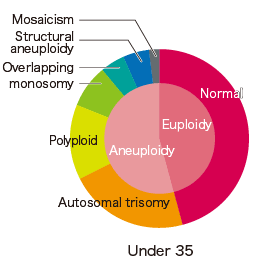
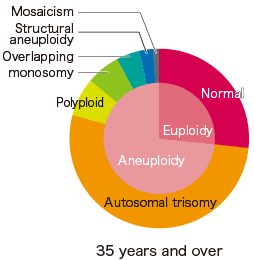
Maribel Grande : Human Reproduction Vol.0 no.0 pp.1-9,2012 was used as the original and made at Oak Medical Group.
Chromosomal anomalies are not only in the miscarried fetus, but are also recognized with a high frequency in regular embryos as well.
As for the embryos having anomalies in chromosomes, most of them will not implant or will end with a chemical pregnancy.
Especially the embryos having aneuploidy in regular chromosomes will either have about a 90% chance they will not implant or end with a chemical miscarriage.
It is called a trisomy when the chromosome gets 1 excessive chromosome to the pair.
In miscarriages, trisomies of regular chromosomes (#1-22) are seen with a high ratio.
If it is 1 extra chromosome on the 3rd chromosome then it is called the 3rd trisomy, and if it is 1 extra chromosome on the 18th chromosome then it is called the 18th trisomy respectively.
Trisomies of regular chromosomes compromise about half the number of chromosomal anomalies of miscarriages.
Amongst these trisomies, the sex chromosome will not lead to a miscarriage.
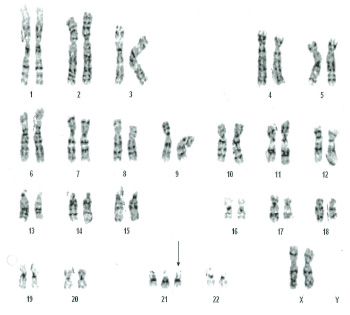
est Results by aCGH (a) of the 11th trisomy and FISH method (b)
(a)
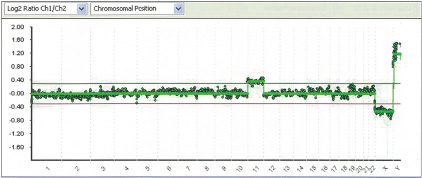
(b)
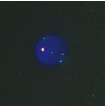
Regularly, where one part of the chromosome pair has been lost, it is called a monosomy.
As for sex chromosomes, in general female is XX, and male is XY. In miscarriages, the X chromosome that has lost the other X is often seen.
However, in normal chromosomal monosomies, the 21st monosomy and the 22nd monosomy are only slightly seen.
In miscarriages, the anomalies of triploidy and tetraploidy are seen in chromosomal anomalies.
The chromosomes had by the oocyte and sperm together are 23 pairs (haploid= 22 pairs of regular chromosomes + 1 set of sex chromosomes).
When the oocyte is fertilized with the sperm, the embryo will have 23+23 for a total of 46 (diploid).
However, if 1 oocyte is fertilized by 2 sperm, the embryo will have 23+23+23 for a total of 69 (triploid), and if fertilized by 4 sperm, the embryo will have 23+23+23+23 for a total of 92 (tetraploid).
This is the anomaly called, “polyploid”, but it will often end in miscarriage and there are seldom any cases that result in birth.
In constructional anomalies of chromosomes, there are 1) reciprocal translocation, 2) Robertson’s translocation, 3) inversions, 4) deletion, 5) insertion, 6) overlapping, 7) ring chromosomes, and 8)dysenteric chromosomes.
From this group, 1) ~ 3) are called balanced structural anomalies, and even though there are anomalies with the shape, there are no excesses or deficiencies in the genetic information amount and thus it will not lead to miscarriage.
As for structural anomalies other than 1) ~ 3) , because there are fluctuations in the genetic information amount, there is a possibility of miscarriage or children being born with developmental defects.
Unbalanced structural anomalies are in cases caused by mutation and in cases where one of the parents has such an unbalanced structural anomaly.
We are providing the general information about Preimplantation Genetic Diagnosis.